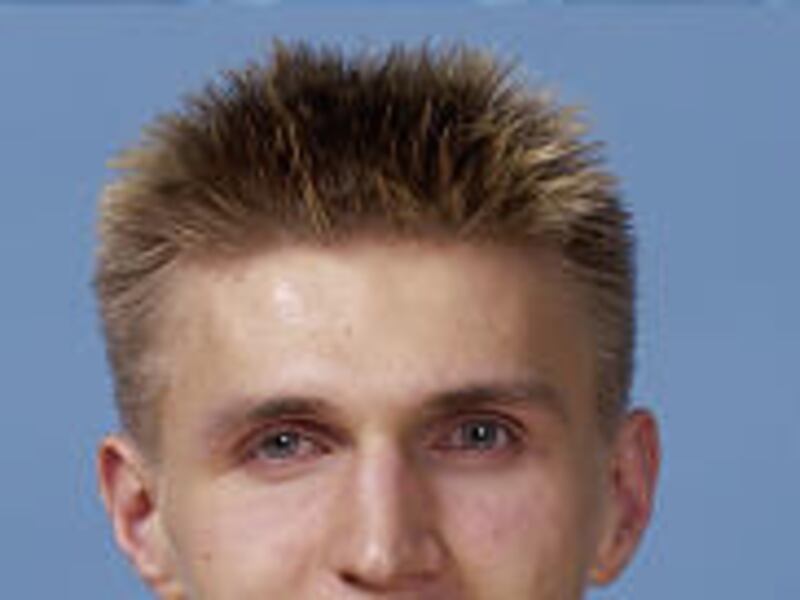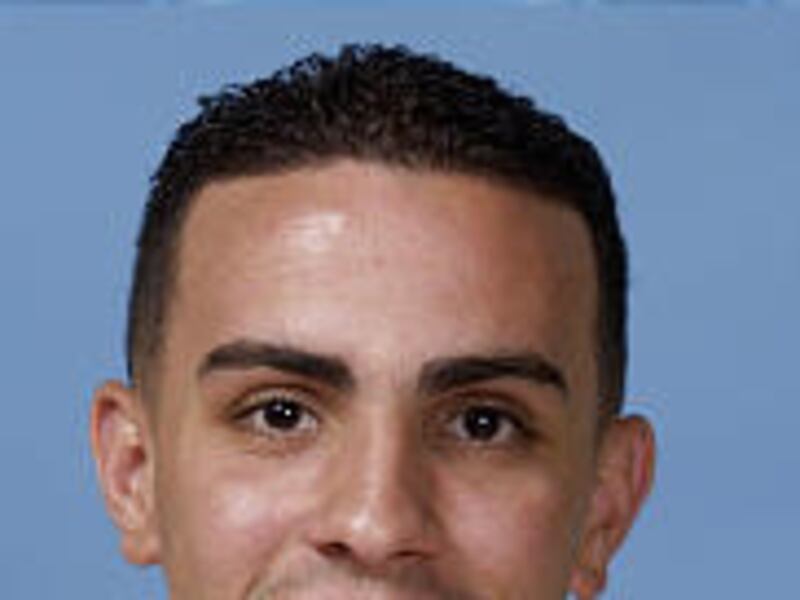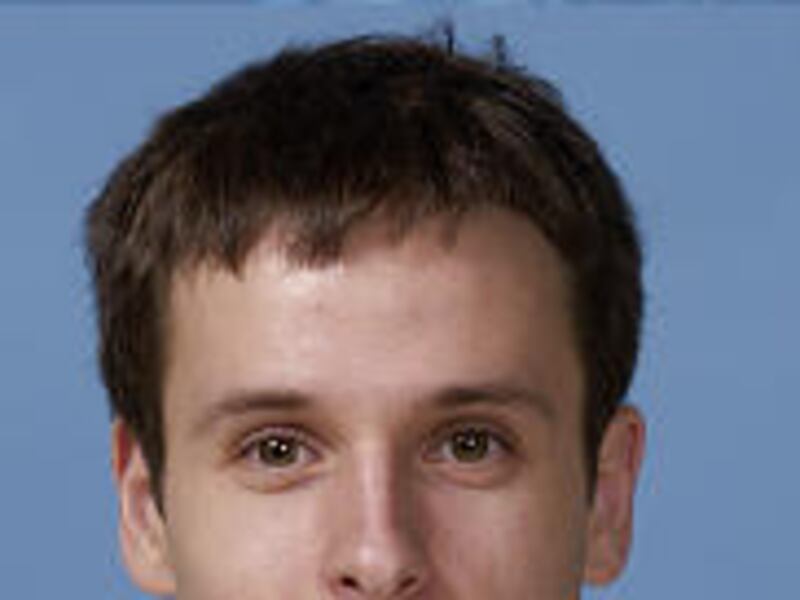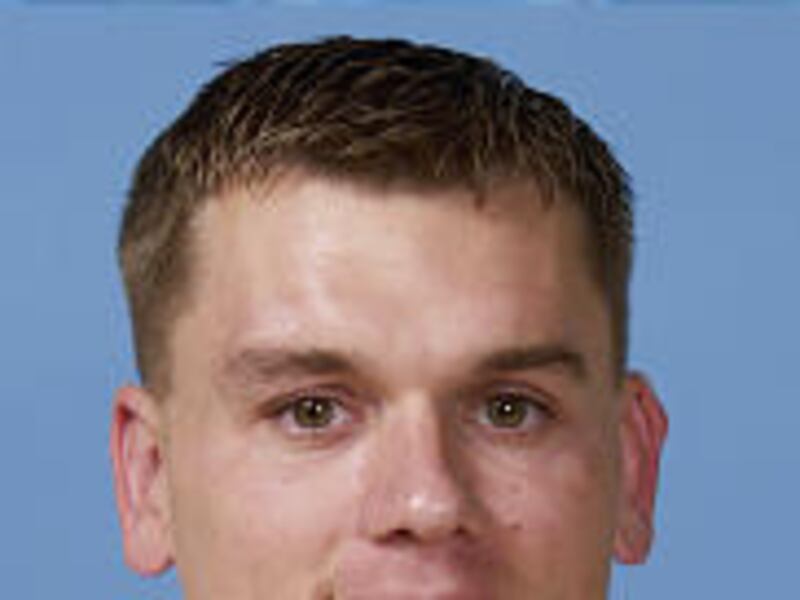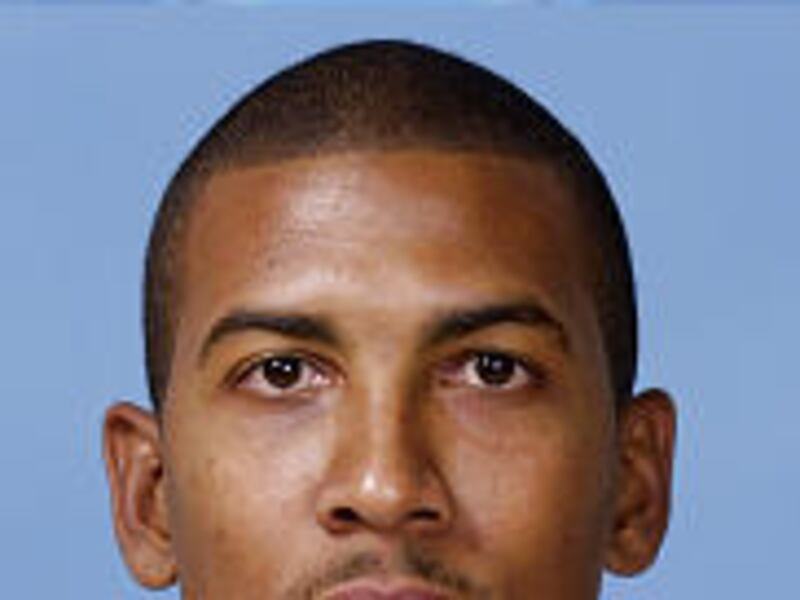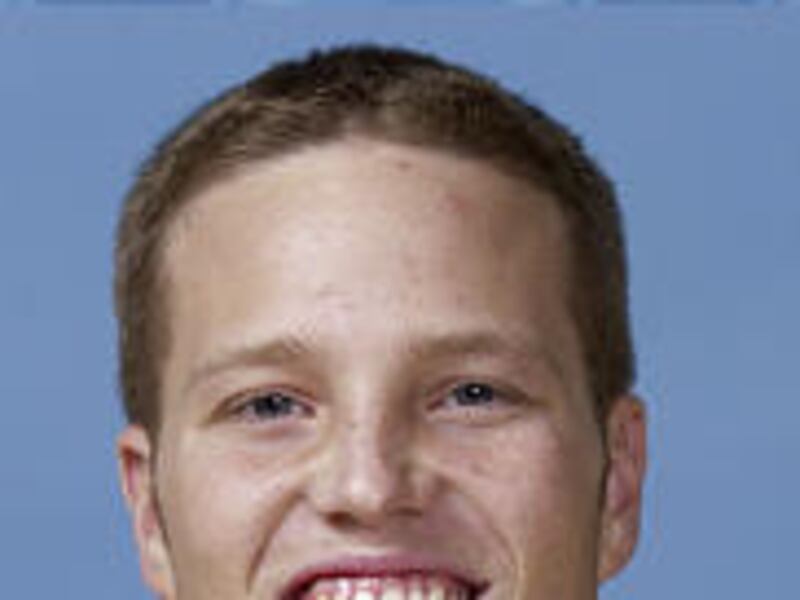Carlos Arroyo
Point guard
6-2, 202
Age: 25. College: Florida International. From: Puerto Rico. NBA season: No. 4. Other NBA teams: Toronto, Denver. How acquired: Signed as free agent, 2002.
Upside: Arroyo stepped into retired John Stockton's starting point position last season, averaging a career-high 12.6 points and team-leading 5 assists per game. He has benefited tremendously from international experience, helping his native Puerto Rico upset the United States at the 2004 Summer Olympics play. He also came to training camp in great shape. Arroyo is quite quick, and a much-improved outside shooter. The Jazz re-signed him for $16 million over four years this past summer.
Down: Jazz coach Jerry Sloan seeks more consistency from Arroyo, who must transition out of the scoring-point mentality he has when playing for Puerto Rico and into the offense-quarterbacking mindset the Jazz system demands. Can Arroyo handle heavy minutes on a night-in, night-out basis?
With backup Raul Lopez's health a concern, he'll have to if the Jazz are to have much success this season. Improved defense also is a must if Arroyo is to continue to keep Sloan content.
Raja Bell
Shooting guard
6-5, 210
Age: 28. College: Florida International. From: U.S. Virgin Islands.
NBA season: No. 5. Other NBA teams: Philadelphia, Dallas. How acquired: Signed as free agent, 2003. Draft status: Undrafted.
Upside: Where should we start? Bell has consistently shot above 40 percent each of the past three seasons. He plays with a tenacity Sloan loves. He'll show up every night. He isn't afraid to take a charge. His defense is, and always has been, strong. He can come off the bench and won't complain, but would not look out of place as a starter. Either way, he's likely to be on the floor at the end of a game — and can be counted on when he is.
Down: Bell is so competitive that he is a bit hot-tempered, and it cost him with several flagrant fouls last season. Some referees seem to grow weary of his frequent complaining. He's a bit undersized, albeit durable and able to make up for what he lacks with impressive quickness. And: He's likely in for a huge hike in pay next summer, so it could cost the Jazz dearly if they want to keep him long-term.
Carlos Boozer
Power forward
6-9, 258
Age: 22. College: Duke. From: Fairbanks, Alaska. NBA season: No. 3.
Other NBA team: Cleveland. How acquired: Signed as free agent, 2004. Drafted: Second round, No. 35 overall, in 2002.
Upside: For starters, he merely averaged a double-double (15.4 points, 11.4 rebounds) in Cleveland last season. But it's not just numbers that got the Jazz so high on Boozer they gave him $68 million over six years — $20 million more than any other team was offering. First, there is the fact they desperately needed 4-spot help — and have since a certain power forward named Karl Malone left Utah. Moreover, it's knowing he's both strong enough and willing to do dirty work inside, scratching for rebounds and clawing for baskets. He can help a pinch at center, too. Finally, he's only 22 — and says he is truly happy to be in Utah.
Down: Boozer's defense is considered rather ordinary. His feet certainly aren't the league's fastest, and at 6-9 he'll be a bit undersized when matched against the likes of Tim Duncan. Boozer also is quite confident, which can work either way. All those factors contributed to his lasting until the 2002 draft's second round — a slip that has more than one NBA general manager doing some hind-side kicking. Another development that could prove detrimental: Many snicker at the debatably questionable way he escaped Cleveland, and that's a burden that may hound him for at least this season.
Curtis Borchardt
Center
7-0, 240
Age: 24. College: Stanford. From: Redmond, Wash. NBA season: No. 2.
Other NBA teams: None. How acquired: Traded from Orlando for Ryan Humphrey and Jamal Sampson, 2002. Draft status: First round by Orlando, No. 18 overall, 2002.
Upside: Borchardt could have untapped potential, though only time will tell. He's smart, he's personable and he's willing to work. Add in the fact he stands 7 feet tall and isn't afraid to play in the post, and those are qualities that should pique the interest of many teams. Also working in his favor is the fact Borchardt knows this could be a make-or-break season in his so-far short NBA career.
Down: Injuries have been Borchardt's Achilles heel, limiting him to no games his first season and just 16 last season. Stress fracture in his foot, broken wrist bones, a broken finger - he's had them all the last two years. Add in the fact the foot bothered him a bit this preseason, and you can color the Jazz leery. One other woe: With so little play, Borchardt hasn't developed the strength needed to win battles inside.
Jarron Collins
Forward/Center
6-11, 255
Age: 25. College: Stanford. From: North Hollywood, Calif. NBA season: No. 3. Other NBA teams: None. How acquired: Drafted in second round, No. 53 overall, 2001.
Upside: Every team likes to have at least one player like Collins. He is smart, can run the offense to perfection, will take a charge, can play two positions (power forward or center), can start or come off the bench (he's done both) and isn't going to cause trouble. He will show up every night, and his production - if not flashy - will be consistent. Collins also comes quite cheap, which would make any general manager smile.
Down: What you see is what you get with Collins. He'll never be much more than he is now, but then again he won't give much less. Rebounding — he averaged less than four boards in 21.4 minutes per game last season — isn't his forte. Finishing in the paint also proves problematic.
Then there are injury concerns: Collins tore an anterior cruciate ligament two seasons ago, and a sprained wrist caused him to miss all but one game this preseason.
Gordan Giricek
Shooting guard
6-5, 210
Age: 27. From: Croatia. NBA season: No. 3. Other NBA teams: Memphis, Orlando. How acquired: Trade with Orlando for DeShawn Stevenson, 2004. Draft status: Second round by Dallas, No. 40 overall, 1999.
Upside: Giricek has consistently shot 43.6 percent from the field in his first two seasons. He's also a strong free-throw shooter, and for a shooting guard is a pretty decent rebounder. When he's on, he's really on, making him a regular low double-digit scorer. Height at the 2 spot helps, too. Easy-going attitude also seems to make Giricek a pleasant person to be around.
Down: Giricek is much more comfortable shooting from mid-range than from behind the 3-point line, though that is not always a bad thing in Sloan's world. He's not much of a catch-and-shoot shooter, but his dribble-before-shooting technique often results in a foul and free-throw line visit. Defense is somewhat suspect. Giricek also has a tendency to want do things his own way, which is a sure-fire route to Sloan's bad side.
Matt Harpring
Forward
6-7, 231
Age: 28. College: Georgia Tech. From: Atlanta. NBA season: No. 7. Other NBA teams: Orlando, Cleveland, Philadelphia. How acquired: Signed as free agent, 2002. Draft status: First round by Orlando, No. 15 overall, 1998.
Upside: Harpring hustles, each and every time he plays. His 16-plus scoring average seems to be no fluke, even though the Jazz do not exactly run many plays for him. He'll scrap, cut, scratch and claw — not just for points, but rebounds as well. Good defender, too. Harpring is a small forward who can swing either way, meaning the Jazz might be as likely to use him at power forward as shooting guard.
Down: How will Harpring come back from last season's season-ending knee surgery? The Jazz wonder. And how will he hold up this season?
Harpring seems to be built as solid as they come, yet he's battled his share of injuries, especially in the ankle and now knee. Then there is the issue of how he will respond to a possible off-the-bench role - or how others will respond if Jazz coach Jerry Sloan decides to stick with Harpring as a starter.
Kris Humphries
Forward
6-9, 235
Age: 19. College: Minnesota. From: Minneapolis. NBA season: Rookie. How acquired: Drafted in first round, No. 14 overall, 2004.
Upside: A ripped-down rebound here, a power follow-jam there — in his first NBA training camp and preseason, Humphries has flashed signs of why he was taken with the Jazz's highest draft pick since Karl Malone went No. 13 overall in 1985. Make no mistake, the kid has a nose for the basket. Good physique, too, especially considering the 2004 Big Ten Freshman of the Year is only 19. With Boozer in place at power forward, the Jazz can afford to bring Humphries along slowly.
Down: Humphries loves to shoot — when it's appropriate, and often when it's not. Sloan could spend all season trying to break that habit. The youngster needs more time to learn the Jazz system. Then there is the question of how he'll respond to the presence of Boozer — since Humphries had to figure he was Utah's power forward of the future, but that seemingly changed when they committed $68 million to a certain someone else.
Andrei Kirilenko
Forward
6-9, 225
Age: 23. From: Russia. NBA season: No. 4. Other NBA teams: None. How acquired: Drafted in first round, No. 24 overall, in 1999.
Upside: Like with a Kirilenko stat sheet, calculating the upside for the 23-year-old takes a few more fingers than 10. He scores, he rebounds, he blocks shots, he makes steals and he'll even dish some assists. Last season he became the Jazz's first All-Star since Malone, and that is because coaches around the NBA love his all-around game. The biggest weapon in Kirilenko's arsenal: incredibly long arms that are especially helpful on the defensive end. He uses them like tentacles, and it really bugs opponents.
Down: Kirilenko is not the world's prettiest shooter — though he has hit above 45 percent from the field in three seasons. It will be interesting to see if his game excels or declines with the additions of Boozer and Mehmet Okur up front. With Boozer at power forward, Kirilenko may play more minutes at small forward — which may or may not work to his advantage. Strength, as always, is an issue as well - with more, he'd play so much better in the post.
Raul Lopez
Point guard
6-0, 160
Age: 24. From Spain. NBA season: No. 2. Other NBA teams: None. How acquired: Drafted in first round, No. 24 overall, in 2001.
Upside: Lopez did not miss a game last season. He was an able backup behind Arroyo, and filled in well as a starter when needed. Lopez plays with reckless abandon and will readily sacrifice his 160-when-soaking-wet body. He's a gym rat, and he'll give all he's got whenever his achy, breaky knee doesn't get in the way.
Down: Turnovers troubled Lopez last season. He made 174, more in nearly 400 fewer minutes than Arroyo's 156. Three-point shooting — he made just 29.4 percent — isn't exactly a strength, either. Then there is his problematic right knee. Twice now, it's been surgically reconstructed. And while it was fine all of last season, Lopez came to camp with weak hamstring and quadricep muscles because he spent so much time in the offseason resting the joint, causing him to miss the entire preseason.
Keith McLeod
Point guard
6-2, 185
Age: 24. College: Bowling Green. From: Canton, Ohio. NBA season: No. 2. Other NBA team: Minnesota. How acquired: Signed as free agent, 2004.
Upside: McLeod was brought to camp to be the Jazz's No. 3 point. He got his first taste of NBA life backing up Sam Cassell in Minnesota for 33 games last season. He's honed his game in Italy, too. He's quick, and showed in college that he can score, averaging 22.9 points. Plays all-out, and impressed the Jazz enough in an offseason workout that they guaranteed $250,000 of his one-year, $750,000 contract.
Down: McLeod was a shooting guard at Bowling Green, but he's trying to play point at the next level. The conversion has had its ups and downs. Turnovers, plus the pressure of just trying to make the team, have plagued him through the preseason. He has seen plenty of playing time with usual backup Raul Lopez out, but hasn't exactly taken full advantage of the opportunity.
Mehmet Okur
Center
6-11, 249
Age: 25. From: Turkey. NBA season: No. 3. Other NBA team: Detroit. How acquired: Signed as free agent, 2004. Draft status: Second round by Detroit, No. 28 overall, 2001.
Upside: Okur is a big man who can shoot. His ability to score from the outside will open things up inside for the Jazz, and his ability to finish is something a Utah center has not had for some time. Okur's free-throw shooting ability should allow him to stay on the floor for the end of games. And he can play power forward, too.
Down: Okur doesn't always take well-advised shots. It looks like his help defense, or lack thereof, is something that will have Sloan harping on him. At 6-11, he's not huge in the 5 spot. After signing a six-year, $50 million free agent contract in the offseason, Okur reported to his first Jazz training camp in less than great shape.
Aleksandar Radojevic
Center
7-3, 250
Age: 28. College: Barton County (Kan.) Community. From: Serbia-Montenegro. NBA season: No. 2. Other NBA teams: Toronto. How acquired: Signed as a non-guaranteed free agent, 2004. Draft status: First round by Toronto, No. 12 overall, 1999.
Upside: Radojevic is big. He can pull down rebounds, block shots, and passes extremely well. Did we say he's big? That's 7-3 big. Radojevic had an early taste of NBA life in 1999, and after a few seasons in Europe he wants back into the league.
Down: He's rather slow, much more so than in his first NBA go-round. Since getting drafted by Toronto, Radojevic has had two surgeries to repair the same herniated disc in his back and he's foul-prone, and at 28 he's no spring chicken, either. But he's big. Boy is he big.
Kirk Snyder
Shooting guard
6-6, 225
Age: 21. College: Nevada. From: Los Angeles. NBA season: Rookie. How acquired: Drafted in first round, No. 16 overall, 2004.
Upside: Snyder is a strong, well-built talent who with time may become a solid contributor. At 6-6, the 2004 WAC Player of the Year is big enough to play shooting guard - yet he has impressive-enough ball-handling skills that Jazz coaches think he can some day help at the point as well. He seems rather mature, too, despite being just 21 and playing only two-and-a-half seasons of college ball.
Down: Playing in the Rocky Mountain Revue certainly helped his cause, but Snyder seems to have a ways to go before he is totally comfortable with all the ins and outs of the Jazz's system. He must improve his outside shooting range, too, as he makes the transition for college ball to the NBA.

